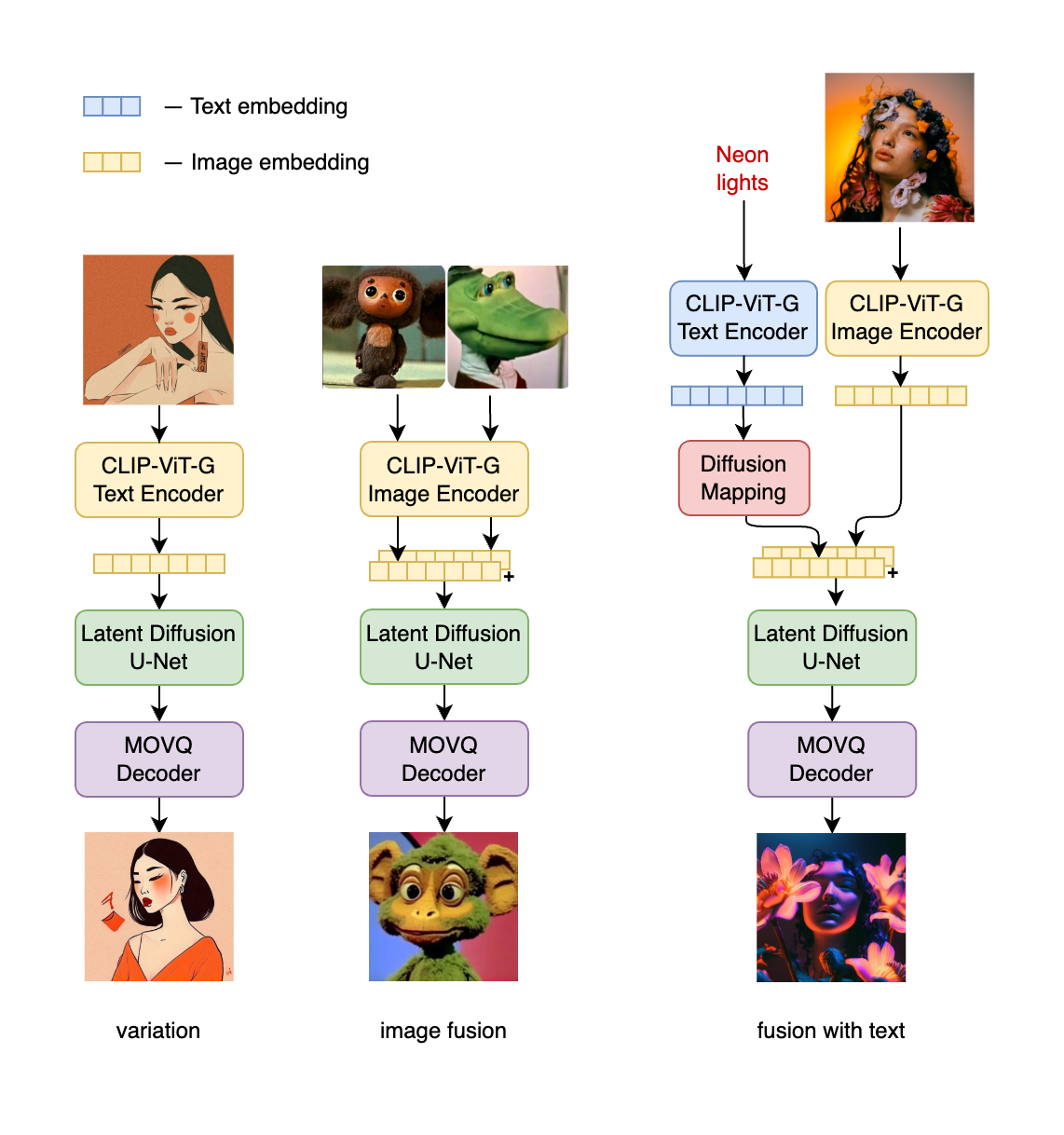Description:
Kandinsky 2.2 brings substantial improvements upon its predecessor, Kandinsky 2.1, by introducing a new, more powerful image encoder - CLIP-ViT-G and the ControlNet support.
The switch to CLIP-ViT-G as the image encoder significantly increases the model's capability to generate more aesthetic pictures and better understand text, thus enhancing the model's overall performance.
The addition of the ControlNet mechanism allows the model to effectively control the process of generating images. This leads to more accurate and visually appealing outputs and opens new possibilities for text-guided image manipulation.
Architecture details:
- Text encoder (XLM-Roberta-Large-Vit-L-14) - 560M
- Diffusion Image Prior — 1B
- CLIP image encoder (ViT-bigG-14-laion2B-39B-b160k) - 1.8B
- Latent Diffusion U-Net - 1.22B
- MoVQ encoder/decoder - 67M
Сheckpoints:
- Prior: A prior diffusion model mapping text embeddings to image embeddings
- Text-to-Image / Image-to-Image: A decoding diffusion model mapping image embeddings to images
- Inpainting: A decoding diffusion model mapping image embeddings and masked images to images
- ControlNet-depth: A decoding diffusion model mapping image embedding and additional depth condition to images
Check our jupyter notebooks with examples in ./notebooks folder
from kandinsky2 import get_kandinsky2
model = get_kandinsky2('cuda', task_type='text2img', model_version='2.2')
images = model.generate_text2img(
"red cat, 4k photo",
decoder_steps=50,
batch_size=1,
h=1024,
w=768,
)pip install "git+https://github.com/ai-forever/Kandinsky-2.git"
Kandinsky 2.1 inherits best practicies from Dall-E 2 and Latent diffusion, while introducing some new ideas.
As text and image encoder it uses CLIP model and diffusion image prior (mapping) between latent spaces of CLIP modalities. This approach increases the visual performance of the model and unveils new horizons in blending images and text-guided image manipulation.
For diffusion mapping of latent spaces we use transformer with num_layers=20, num_heads=32 and hidden_size=2048.
Other architecture parts:
- Text encoder (XLM-Roberta-Large-Vit-L-14) - 560M
- Diffusion Image Prior — 1B
- CLIP image encoder (ViT-L/14) - 427M
- Latent Diffusion U-Net - 1.22B
- MoVQ encoder/decoder - 67M
Kandinsky 2.1 was trained on a large-scale image-text dataset LAION HighRes and fine-tuned on our internal datasets.
Check our jupyter notebooks with examples in ./notebooks folder
from kandinsky2 import get_kandinsky2
model = get_kandinsky2('cuda', task_type='text2img', model_version='2.1', use_flash_attention=False)
images = model.generate_text2img(
"red cat, 4k photo",
num_steps=100,
batch_size=1,
guidance_scale=4,
h=768, w=768,
sampler='p_sampler',
prior_cf_scale=4,
prior_steps="5"
)prompt: "Einstein in space around the logarithm scheme"
from kandinsky2 import get_kandinsky2
from PIL import Image
model = get_kandinsky2('cuda', task_type='text2img', model_version='2.1', use_flash_attention=False)
images_texts = ['red cat', Image.open('img1.jpg'), Image.open('img2.jpg'), 'a man']
weights = [0.25, 0.25, 0.25, 0.25]
images = model.mix_images(
images_texts,
weights,
num_steps=150,
batch_size=1,
guidance_scale=5,
h=768, w=768,
sampler='p_sampler',
prior_cf_scale=4,
prior_steps="5"
)from kandinsky2 import get_kandinsky2
from PIL import Image
import numpy as np
model = get_kandinsky2('cuda', task_type='inpainting', model_version='2.1', use_flash_attention=False)
init_image = Image.open('img.jpg')
mask = np.ones((768, 768), dtype=np.float32)
mask[:,:550] = 0
images = model.generate_inpainting(
'man 4k photo',
init_image,
mask,
num_steps=150,
batch_size=1,
guidance_scale=5,
h=768, w=768,
sampler='p_sampler',
prior_cf_scale=4,
prior_steps="5"
)pip install "git+https://github.com/ai-forever/Kandinsky-2.git"
It is a latent diffusion model with two multilingual text encoders:
- mCLIP-XLMR 560M parameters
- mT5-encoder-small 146M parameters
These encoders and multilingual training datasets unveil the real multilingual text-to-image generation experience!
Kandinsky 2.0 was trained on a large 1B multilingual set, including samples that we used to train Kandinsky.
In terms of diffusion architecture Kandinsky 2.0 implements UNet with 1.2B parameters.
Kandinsky 2.0 architecture overview:
Check our jupyter notebooks with examples in ./notebooks folder
from kandinsky2 import get_kandinsky2
model = get_kandinsky2('cuda', task_type='text2img')
images = model.generate_text2img('A teddy bear на красной площади', batch_size=4, h=512, w=512, num_steps=75, denoised_type='dynamic_threshold', dynamic_threshold_v=99.5, sampler='ddim_sampler', ddim_eta=0.05, guidance_scale=10)prompt: "A teddy bear на красной площади"
from kandinsky2 import get_kandinsky2
from PIL import Image
import numpy as np
model = get_kandinsky2('cuda', task_type='inpainting')
init_image = Image.open('image.jpg')
mask = np.ones((512, 512), dtype=np.float32)
mask[100:] = 0
images = model.generate_inpainting('Девушка в красном платье', init_image, mask, num_steps=50, denoised_type='dynamic_threshold', dynamic_threshold_v=99.5, sampler='ddim_sampler', ddim_eta=0.05, guidance_scale=10)prompt: "Девушка в красном платье"
from kandinsky2 import get_kandinsky2
from PIL import Image
model = get_kandinsky2('cuda', task_type='img2img')
init_image = Image.open('image.jpg')
images = model.generate_img2img('кошка', init_image, strength=0.8, num_steps=50, denoised_type='dynamic_threshold', dynamic_threshold_v=99.5, sampler='ddim_sampler', ddim_eta=0.05, guidance_scale=10)








